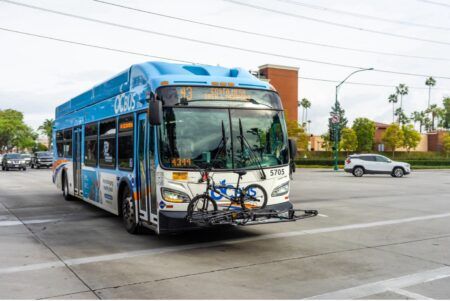A research project in Texas has been examining the latest connected, automated and autonomous vehicle applications to help improve transit, cyclist and pedestrian safety.
Sponsored by the Texas Department of Transportation (TxDOT) and conducted by the Texas A&M Transportation Institute (TTI), the ‘Automated and Connected Vehicle Test Bed to Improve Transit, Bicycle, and Pedestrian Safety Project’ is part of TxDOT’s Innovative Projects Program.
In 2014 the agency supplemented its Cooperative Research Program with the Innovative Projects Program to proactively address issues before they become problems and to explore applications of rapidly evolving technologies. At the beginning of the project, TTI held meetings and workshops with multimodal stakeholders and conducted a technology scan to identify four near-term applications, three of which focus on collision avoidance with turning transit vehicles, straight-line travel and fixed objects. A fourth application is addressing the safety of bike-racks on buses. In the longer term, the research team is focused on the technologies associated with moving toward autonomous buses, with the next step of the project looking at developing the concept of operations.
Concerns found in the initial research include buses making turns at intersections or traveling in a straight line and negatively interacting with cyclists and pedestrians, as well as distracted cyclists and pedestrians not being aware of surrounding transit vehicles. While developing the concept of operations, the team discovered that the Mobileye/Rosco Vision Systems technology was available and that the manufacturer was interested in testing the collision avoidance system in a campus setting.
Working in partnership with Texas A&M University Transportation Services, the Mobileye/Rosco Shield+ collision-avoidance system was installed on one university bus that traverses the heart of the campus, passing thousands of students daily. The system provides two types of warnings to the bus driver: a yellow light illuminates when a pedestrian or cyclist is detected within range of the bus, alerting the driver to proceed with caution; a red light illuminates and a buzzer sounds when a pedestrian or cyclist is very close to the bus, alerting the driver to stop to avoid a possible collision. The research team is currently assessing the system and developing the overall concept of operations plan for the test bed.
“The system has four cameras that are essentially aimed at the blind spots on the bus and where pedestrians and cyclists are most likely to show up and be in harm’s way,” explained Shawn Turner, head of TTI’s Mobility Division. “What’s special about this technology is that it is able to detect when there’s an object that’s moving that looks like a person or a cyclist. One of the big blind spots on a bus occurs while making a turn. Two of the cameras are positioned to eliminate those blind spots, creating a safer environment for the driver, pedestrians and cyclists. The nature of a large passenger bus is that when it turns, it sweeps a big arc. In other words, it takes up more space than a car when turning.”




